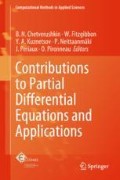Abstract
The reduced basis method allows to propose accurate approximations for many parameter dependent partial differential equations, almost in real time, at least if the Kolmogorov n-width of the set of all solutions, under variation of the parameters, is small. The idea is that any solutions may be well approximated by the linear combination of some well chosen solutions that are computed offline once and for all (by another, more expensive, discretization) for some well chosen parameter values. In some cases, however, such as problems with large convection effects, the linear representation is not sufficient and, as a consequence, the set of solutions needs to be transformed/twisted so that the combination of the proper twist and the appropriate linear combination recovers an accurate approximation. This paper presents a simple approach towards this direction, preliminary simulations support this approach.
Access this chapter
Tax calculation will be finalised at checkout
Purchases are for personal use only
Notes
- 1.
Note that, of course, this choice of an explicit scheme involves a limitation on the time step due to a CFL condition that can be severe for an accurate finite element or finite difference scheme but reveals to be moderate in the reduced basis framework.
- 2.
Indeed there is no reason why using the same discretization in time for the truth solution and for the reduced basis scheme.
References
Abgrall R, Amsallem D, Crisovan R (2016) Robust model reduction by \(L^1\)-norm minimization and approximation via dictionaries: application to linear and nonlinear hyperbolic problems. Adv Model Simul Eng Sci 3(1)
Beyn W-J, Thümmler V (2004) Freezing solutions of equivariant evolution equations. SIAM J Appl Dyn Syst 3(2):85–116
Binev P, Cohen A, Dahmen W, DeVore R, Petrova G, Wojtaszczyk P (2011) Convergence rates for greedy algorithms in reduced basis methods. SIAM J Math Anal 43(3):1457–1472
Cagniart N (2017) PhD thesis, University Pierre et Marie Curie, In preparation
Carlberg K (2015) Adaptive \(h\)-refinement for reduced-order models. Int J Numer Methods Engrg 102(5):1192–1210
Carlberg K, Bou-Mosleh C, Farhat C (2011) Efficient non-linear model reduction via a least-squares Petrov-Galerkin projection and compressive tensor approximations. Int J Numer Methods Engrg 86(2):155–181
Carlberg K, Farhat C, Cortial J, Amsallem D (2013) The GNAT method for nonlinear model reduction: Effective implementation and application to computational fluid dynamics and turbulent flows. J Comput Phys 242:623–647
Cohen A, DeVore R (2016) Kolmogorov widths under holomorphic mappings. IMA J Numer Anal 36(1):1–12
Dahmen W, Plesken C, Welper G (2014) Double greedy algorithms: reduced basis methods for transport dominated problems. ESAIM Math Model Numer Anal 48(3):623–663
DeVore R, Petrova G, Wojtaszczyk P (2013) Greedy algorithms for reduced bases in Banach spaces. Constr Approx 37(3):455–466
Gerbeau J-F, Lombardi D (2014) Approximated Lax pairs for the reduced order integration of nonlinear evolution equations. J Comput Phys 265:246–269
Hesthaven JS, Rozza G, Stamm B (2016) Certified reduced basis methods for parametrized partial differential equations. Springer, Cham (BCAM Basque Center for Applied Mathematics, Bilbao)
Iollo A, Lombardi D (2014) Advection modes by optimal mass transfer. Phys Rev E 89(2):022923
Lø vgren AE, Maday Y, Rø nquist EM (2006) A reduced basis element method for the steady Stokes problem. M2AN Math Model Numer Anal 40(3):529–552
Maday Y, Manzoni A, Quarteroni A (2016) An online intrinsic stabilization strategy for the reduced basis approximation of parametrized advection-dominated problems. C R Math Acad Sci Paris 354(12):1188–1194
Maday Y, Patera AT, Turinici G (2002) A priori convergence theory for reduced-basis approximations of single-parameter elliptic partial differential equations. J Sci Comput 17(1–4):437–446
Melenk J-M (2000) On \(n\)-widths for elliptic problems. J Math Anal Appl 247(1):272–289
Nguyen N-C, Rozza G, Patera AT (2009) Reduced basis approximation and a posteriori error estimation for the time-dependent viscous Burgers’ equation. Calcolo 46(3):157–185
Ohlberger M, Rave S (2013) Nonlinear reduced basis approximation of parameterized evolution equations via the method of freezing. C R Math Acad Sci Paris 351(23–24):901–906
Quarteroni A, Manzoni A, Negri F (2016) Reduced basis methods for partial differential equations: an introduction, vol 92. Unitext. Springer, Cham
Taddei T, Perotto S, Quarteroni A (2015) Reduced basis techniques for nonlinear conservation laws. ESAIM Math Model Numer Anal 49(3):787–814
Veroy K, Prud’homme C, Patera AT (2003) Reduced-basis approximation of the viscous Burgers equation: rigorous a posteriori error bounds. C R Math Acad Sci Paris 337(9):619–624
Acknowledgements
This paper is dedicated to Professor Olivier Pironneau on the occasion of his 70th birthday. The French government is greatly acknowledged for its funding of the FUI MECASIF project.
Author information
Authors and Affiliations
Corresponding author
Editor information
Editors and Affiliations
Rights and permissions
Copyright information
© 2019 Springer International Publishing AG, part of Springer Nature
About this chapter
Cite this chapter
Cagniart, N., Maday, Y., Stamm, B. (2019). Model Order Reduction for Problems with Large Convection Effects. In: Chetverushkin, B., Fitzgibbon, W., Kuznetsov, Y., Neittaanmäki, P., Periaux, J., Pironneau, O. (eds) Contributions to Partial Differential Equations and Applications. Computational Methods in Applied Sciences, vol 47. Springer, Cham. https://doi.org/10.1007/978-3-319-78325-3_10
Download citation
DOI: https://doi.org/10.1007/978-3-319-78325-3_10
Published:
Publisher Name: Springer, Cham
Print ISBN: 978-3-319-78324-6
Online ISBN: 978-3-319-78325-3
eBook Packages: EngineeringEngineering (R0)

